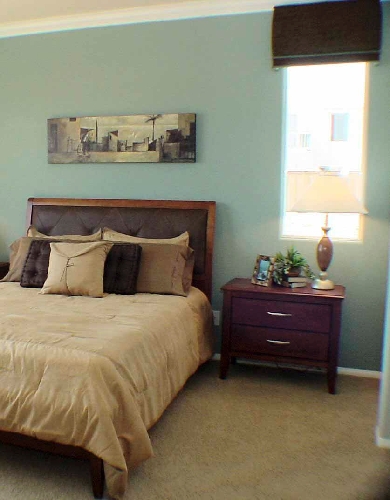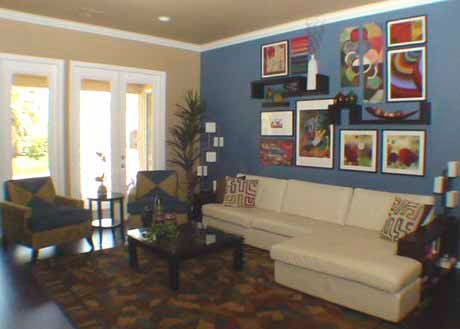Guidelines help conquer common decorating issues


When I’m working with a client I always have them make a list of questions for our appointment. A lot of questions come up and I want to make sure we don’t forget anything, as well as answer as many as I can in our time together. So here are the top 10 questions I’ve been asked in the last three months.
1. Can I use a dark color in my powder bath? Won’t it make it look smaller? This has been my number one question in the last couple of months. My answer is yes and yes. You can use a dark color in your powder bath and it will make the room feel smaller, but it’s a powder bath. Unless you mirror the whole room it’s not going to look any bigger than it already is. Make a statement; your guest will only be in there a few minutes.
2. Do I have to have upper cabinets in my kitchen? Of course not, there are no rules here. It’s all about what you like and want. Right now I’m working on two kitchens where we’re eliminating the uppers and adding shelves. It’s a great way to display colorful dishes or collections. But you must keep the shelves tidy and I’d watch how much you keep on your counters. Too much eye clutter will make for a messy kitchen.
3. What size chandelier do I need over my dining room table? And how high should I hang it? There are a couple of thoughts on the size of a chandelier. Some say that the diameter should be about half of the width of the table it will hang over. Others say the light fixture should be two-thirds of the width of the table. I deduct 1 foot from the width of a rectangular or square dining table. With a rectangular table you, of course, can use a round fixture, just don’t have it wider than the table. Rooms with a high ceiling or that have a large round dining table most times can accommodate a larger chandelier.
As far as the height, it’s important to hang a chandelier high enough so that you can see each other across the table. The height range I work with is 30-42 inches, with 36 inches being the norm. But never go higher than 42 inches. For me it’s about the weight of the chandelier as well as the table. To calculate the best height, you can use this as a guideline. If your ceiling is 8 feet high, the bottom of the chandelier should be 30 inches above the table. For a higher ceiling, the chandelier may be raised 3 inches for every foot of ceiling height above 8 feet. So for a 10-foot ceiling the height would be 36 inches (30+6).
4. How do I know where to start and stop my paint? It’s easy to paint a single room, but when looking at open areas it can get tricky. I always try to stop paint in an inside corner. It’s really hard to get a straight line on the rounded outside edges of your walls because of our texture, even with painter’s tape it can seep through. So always stop paint in a corner or edge, never on a wall.
5. Is wallpaper still in? Wallpaper has never been completely “out,” but has gone in waves of popularity. It’s no different than any other style or fashion. I’m a believer that if you like wallpaper, use it. Manufacturers have come a long way in updating their designs. Kitchens and baths are the number one places where it’s being used.
6. How much paint do I need? Most paint cans tell you how much area they cover. Normally, 1 gallon can cover as much as 200-400 square feet, depending on the color you’re covering, the color you’re using and the type of paint on the wall. If you’re covering a darker color with a lighter color, 1 gallon will cover less. If you’re using dark over light, it might go a little further. If you have flat paint on the walls, it will absorb more paint than if you were covering a satin or semigloss finish. If in doubt, buy more as you’ll want some for touch-ups. And always check with the paint store on what it recommends.
7. Do I have to have matching finishes on all of my hardware, faucets and light fixtures in my house? No, everything does not have to match and can be very expensive if you’re looking to just update and don’t want to replace them all. To keep it easy and simple, keep the same finish on all of the doors. Use the same finish on your faucets and light fixtures in the kitchen and each bath. But they don’t have to be the same in every bath.
8. What size area rug should I buy? When placing a rug under a dining table, you want to make sure that when the chairs are fully pulled out, all the chair legs are on the rug. You don’t want to be rocking in your chair when you’re eating and catching a chair leg on the edge of the rug is dangerous.
For under your upholstery, a lot depends on the room size, furniture placement and the traffic flow in and out of the room and area. The first concern with any area rug is safety and tripping. Do not have it extend out into any of the traffic flow areas, so watch if you’ll be stepping on it coming around a corner or walking through the room.
I like for at least the front legs to be on the rug. Others will disagree and feel that all legs must be on the rug. One thing I do not like when all the legs are not on the rug is any rocking of the furniture. So you’ll either have to level the legs with pads or place all the legs on the rug.
9. I want to paint but can’t afford to paint the whole house. Can I just paint a couple of areas and if so which ones? You bet you can. Some color is better than no color until you can paint the whole house. My favorite places for accent paint are kitchen backsplash, master bedroom headboard wall, wall opposite the mirror in a bathroom, fireplace wall, art niches and the back of any pot shelves.
10. Is it OK not to have blinds on a window? Absolutely, as long as you don’t have any privacy or sun control issues. Nothing says that because you have a window you have to put blinds on it, especially if all you’re going to do is pull them up. I only have a decorative treatment on my back nook window; I like to look straight out into my backyard. Unless my neighbor in the back climbs up his 20-foot sloped yard no one can see in, and if he does, he’s welcome to look in.
Gail Mayhugh, owner of GMJ Interiors, is a professional interior designer and author of a book on the subject. Questions may be sent by email to: gail@gmjinteriors.com. Or, mail to: 7380 S. Eastern Ave., No. 124-272, Las Vegas, NV 89123. Her Web address is: www.GMJinteriors.com.












